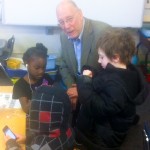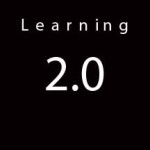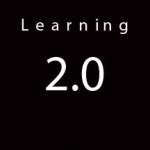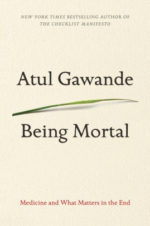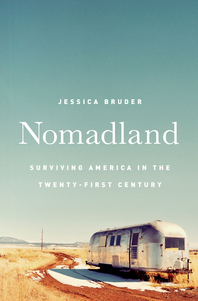High Tech High and Networks of Ideas
Posted on | July 10, 2012 | Comments Off on High Tech High and Networks of Ideas
Today I published a long-in-the-works case study of High Tech High, the collection of schools in San Diego County that follow the same design and operating principles.
Each of the 11 HTH schools is small, a maximum of 125 students per grade, and personalized. Each of the schools follows a project-based curriculum that requires students to make connections to the adult world, through projects and internships that are critical in helping students set their sights higher and aim toward college. Each of the schools follows what the school calls a “common intellectual mission” integrating head and hand. There are no classes labeled “gifted,” and whenever possible special education students are fully integrated into regular classes and projects.
Finally, the schools work around the principle that it is the teacher who designs the curriculum. There are no packaged programs of instruction, and the schools have not outsourced the intellectual core of teaching and learning. Adult conversations and collaboration are prized and built into the schools’ daily schedules.
Like all visitors, I was charmed by the schools: Students having fun while fully engaged in projects. Scores of books written and published. Interesting multimedia projects. Enthusiastic teachers who are articulate about their craft and art.
But it was a public policy puzzle that drew me to HTH. How does a group of attractive charter schools replicate success? HTH decided that, unlike KIPP, it would not franchise, nor would it grow to a divisional corporate form. (HTH has a statewide charter allowing it to start up to 48 schools, but it does not plan to expand much, preferring a very slow process in which new schools are founded by veteran leadership from older ones so that the culture of the schools moves with the people.) HTH can’t be packaged and sold as a program of instruction the way publishers do. So, how do others take away the lessons of HTH and weave them at home?
Thus far the answer seems to be a loose network of teachers and administrators who are willing to spend the time understanding HTH in some depth. HTH runs its own graduate school, and one of its activities is the Leading Schools program where educators from around the world come together understand the existing HTH model and how to adapt it.
In many ways, it’s idea leadership at its best.
Tags: Ben Daley > Bob Riordan > High Tech High > Larry Rosenstock > Project Based Learning > Stacey Callier
Innovation Unit Site Worth A Visit; Their New Report Features High Tech High and Project-Learning
Posted on | April 21, 2012 | Comments Off on Innovation Unit Site Worth A Visit; Their New Report Features High Tech High and Project-Learning
The growing literature on rigorous project-based learning includes a new report by Alec Patton of the Innovation Unit in London, Work That Matters. It is built in part around the experience of High Tech High in San Diego, and also includes vignettes from the Chramlington Learning Village in Northumberland, UK, and the Beal Elementary School in Springfield, MA. The report was also supported by the Paul Hamlyn Foundation.
The book includes the basics of project-based-learning—exhibition, multiple drafts, and critique—and provides lots of examples, resources, and even forms for teachers to use. It, along with recent postings by Edutopia, is a good place to start for teachers and schools exploring how to better engage students.
The Innovation Unit, itself, is also worth a visit. The organization exists to bring radical innovation to the public services, particularly in education, early childhood services, local government, and health. Its board is chaired by Australian educator Tony Mckay.
Their work in education struck me in part because of the similarity between some of their ideas, such as 10 Ideas for 21st Century Learning and the set of ideas I’ve been writing about in the Learning 2.0 series of posts. Their site is well worth a visit.
Tags: Alec Patton > High Tech High > Innovation Unit > Tony Mckay
The Road to Learning 2.0: Publishing as an Incentive To Practice Writing
Posted on | April 6, 2012 | Comments Off on The Road to Learning 2.0: Publishing as an Incentive To Practice Writing
Ben Heckman, an 8th grader from Framington, MN, is a twice-published novelist whose story was told in a New York Times piece about the growing number of young writers who break into print, usually with a little bankrolling from their parents. Hundreds of teenage and younger authors are publishing every year.
The Times story by Elissa Gootman also illustrates what I call Learning 2.0, the next full scale upgrade of public education. The authors in her story all wrote fiction, but publishing non-fiction student work also is an important pedagogy, a departure from the century-old acquisition-and-storage model of learning. Publishing student work is an act of exhibition, an invitation for people to view and comment on it, and a validation of self worth of the writer. Publication says that students can do something, know something, and be something.
My exhibit “A” resides at High Tech High in San Diego, where 60 books are listed on the school’s web site creating both examples of the school’s own ideas about its best work and the transparency through which others can judge it. (I’m writing a case study of the school that should be published soon.)
San Diego Bay begins about 200 yards from the HTH Point Loma campus. It serves as a social and scientific laboratory, and students have written four books about the bay and its environs. One of them, San Diego Bay: A Story of Exploitation and Restoration, was published by the University of California, San Diego, and supported by the National Sea Grant program.
Through a series of projects developed by teachers Jay Vavra in biology, Tom Fehrenbacher in humanities, and Rod Buenviaje in mathematics, students interviewed Native Americans, Chinese fishermen, and hunters. They follow the fortunes of tuna, sea lions, white sea bass, abalone, and dolphins. They applied Jared Diamond’s themes from Guns, Germs, and Steel to the Bay. They ended by saying, “Only when we realize that all the pieces of the bigger picture we call nature must be considered will we be capable of sustainably using the Bay, and the rest of the world’s environment, to its fullest extent.”
Several other groups of students, and their teachers, have produced “alphabet books” or dictionaries on academic disciplines. Andrew Gloag’s students published Absolute Zero, which illustrates physics terms. “A is for Antimatter” writes Kathy Anderson, explaining that high energy antimatter engines are still si fi stuff, but that PET (Positron Emission Tomography) scans of brain activity exemplifies a practical application of the science.
Jenny Morris and a biology class at HTH Chula Vista, wrote Alphabet Soup: The A-Z of Cell Biology, about which Morris comments: “This book is living proof that students will aspire to and reach the high expectations you set for them, if you provide a safe and supportive environment in which to try, fail, try again, and eventually succeed.”
Dan Wise’s economics students produced posters explaining economic terms in language a junior high school student could understand. (Students had to test their examples on them. If a sixth grader couldn’t understand; start over.) Think: could you define a “moral hazard” or a “free rider”? In the process of creating these examples, the students learned the underlying economics, concise writing, and design. They illustrated each defined term with linoleum block prints that became part of the posters, and the posters and definitions became part of a book, Economics Illustrated.
Ben Daley, HTH chief operating officer, sees great value in publishing student work: “I have observed the pride that many students feel at having their words and their work appear in print. One of my high school senior advisees solemnly observed to my advisory group, ‘I’m a published author now.’ I believe that micro-publishing is an opportunity that allows almost any teacher to work alongside students to produce high quality products in which students not only absorb new information but also transform it to help make it their own, as well as develop important skills such as learning to work well in a group and the ability to effectively communicate one’s ideas.”
Exhibition also creates incentive among students. As HTH art teacher Jeff Robin says, “If you think that you are an artist, but your paintings are only in your mother’s garage, you’re really not an artist; you’re just cluttering up your mother’s garage.” Teacher and students need to know where the project will live. “If you know that the project will be displayed in an art gallery in downtown San Diego and your family and friends are going to be there, you are going to want to do a better job.”
Publishing does not substitute for practice in writing, just as performing does not substitute for practice in music, or playing does not substitute for practice in soccer. In his book, Outliers, Malcolm Gladwell posits the 10,000-hour rule, the length of time it takes to master most anything. Exhibition as pedagogy does not assert that it creates prodigies; it simply creates more opportunities for practice that is subject to critique. In a way, it’s serious play, and incentivized learning in ways that receiving a traditional red-penciled paper from a teacher decidedly is not.
Tags: Elissa Gootman > High Tech High > New York Times > student publishing > student writing
A Quick Look at ‘Students as the Real Workers in the Education System’ in Riverside
Posted on | March 10, 2012 | Comments Off on A Quick Look at ‘Students as the Real Workers in the Education System’ in Riverside
Part of Learning 2.0 is being Beta tested in the Riverside Unified School District, the 43,000-student school system 60 miles east of Los Angeles.
At the invitation of Superintendent Rick Miller, I undertook a blitzkrieg tour of Riverside schools last week and came away impressed with how they have pushed the envelope of teaching and learning toward the five principles of Learning 2.0. They have done so without leaving traditional schooling behind.
Impressively, everyone I talked to in RUSD understands what they are doing is a work in progress, an on-going experiment in teaching and learning. Not everything they have tried has turned out the way that they thought it would. Their virtual high school, for example, serves more students in a blended learning mode than it does students who take all their lessons on line. So, they are paying a lot more attention to the advantages of technology as an option for students enrolled at a brick and mortar school. Smart whiteboards didn’t seem to increase student achievement. So, they are using them less. RUSD uses a lot of technology, but the goal to support learning, not to show off digital toys.
Second, the schools have wisely chosen to retain a great deal of what is traditional and valued about schooling. Parents, educators, and administrators steeped in Learning 1.0 will see schools and teaching that they understand and recognize. I still need to better understand how students and teachers blend the old and new, how they step to the edges of their comfort zone without vertigo. Movement to the edges is the hardest for administrators, I think. They have both personal stakes and a sense of entitlement rooted in the old system.
In Learning 2.0, schooling operates under the realization that students, rather than the adults, are the real workers in the system. RUSD recognized this. The district’s technology initiatives have been built around getting consumer level electronics—tablets and pods—in the hands of students and giving them a lot of freedom over how they use those devices.
In several schools, every student is issued a tablet computer or a handheld device. (Students prefer tablets to laptops.) They can take then home, put their own music and games on them. So far, the loss and theft rate has been low, and the district has spent less money on replacements than it previously spent on lost textbooks.
I visited a kindergarten at Pachappa Elementary School, where each of the students was working on an iPod. They were all working independently, and they seemed to know what they were doing. Instructional technology director Jay McPhail said that for the most part the district has not found it necessary to hire adults to teach the students how to use new technologies; the students teach each other. They also self enforce to a degree. In the kindergarten class I visited, one student was correcting another who had strayed from the assignment into another application.
The district is also rolling out a dashboard that contains student progress indicators that are updated almost every day. The dashboard delivers current, necessary data, not all the minutia schools collect. Each student gets data on five or six key variables, including how they are doing on the requirements for admission to California colleges and universities. Student dashboards, along with their texts, are available on district-issued Android tablets. But the district’s system works regardless of the platform the student chooses. Some students use iPads they have received as a gift or bought with the proceeds from part time jobs. Read more
Tags: California Student Bill of Rights Initiative > Rick Miller > Riverside Unified School District
Learning 2.0 The Movie, Again with Fixes
Posted on | March 6, 2012 | Comments Off on Learning 2.0 The Movie, Again with Fixes
The first version of Learning 2.0, The Movie was a little fuzzy so I engineered it again and resent it to YouTube. This one should be of higher quality. Thanks for watching.
Tags: Keynote presentation
Critiques of Learning 2.0 and Some Responses. Thanks To All
Posted on | March 2, 2012 | Comments Off on Critiques of Learning 2.0 and Some Responses. Thanks To All
I’ve received some response to the Politics of Learning 2.0, much of it helpfully critical. Here, in a nutshell, are some amendments that these critiques have spurred. Thanks to all for your thoughts. What follows are comments followed by my reactions.
I’m not sure Learning 2.0 is a good basis for all of education. Some teachers will have the initiative and smarts to pull it off, but is this replicable by all. Doubtful?
I made a serious error, I believe, in not explicating the software metaphor that lies behind the transition between Learning 1.0 and Learning 2.0. Smart software designers understand backward compatibility. Learning 2.0 builds on rather than replaces the previous version. Projects don’t replace direct instruction. Working across disciplines does not replace working in them. These are points that will be made in a revision of the report you read.
Building Learning 2.0 on the shoulders of Learning 1.0 supports direct instruction and also fosters the systematic development of projects, internships, sophisticated career/technical education, and other forms of combined head-and-hands learning builds capacity in the public education system. Building capacity is the central argument: California needs to switch its policies from the endless seesaw between more regulation and more deregulation in governance to systematically building capacity. One of the ways to do that is to build something like Learning 2.0.net: an information, teaching, and testing utility. Read more
Pictures Added to the Gallery; Take A Look
Posted on | February 19, 2012 | Comments Off on Pictures Added to the Gallery; Take A Look
There are new pictures in the gallery, including the image shown here of Death Valley in the early morning. I had rolled out of bed at Stovepipe Wells before dawn in order to capture the rising sun over the desert. This, with a little enhancement, is one of the results.
In addition, there are the best of non-family pictures from 2010, and 2011, some taken close to home, many of them in the Baltic, Hawaii, and Italy. I hope you enjoy viewing them as much as I did making them.
Learning 2.0.net: A Way to Create Winners and Increase the Capacity of Public Education
Posted on | January 24, 2012 | Comments Off on Learning 2.0.net: A Way to Create Winners and Increase the Capacity of Public Education
Over the last two years, I have been researching and writing about Learning 2.0, the next full scale version of public education.
I started the research to find a way through the political gridlock of education politics, not because I considered myself an expert in learning theory or pedagogical practice. I think I have.
In a report to the John Randolph and Dora Haynes Foundation, which supported my research, I called for the creation of Learning 2.0.net, a public venture that would change how students learn, how teachers work, and how students gain credit for what they do.
Learning 2.0.net is both possible and necessary because the leading schools are departing from the century-old industrial batch-processing model in two ways. First, they use a form of flexible specialization, a means of production capable of responding to the needs of individual students quickly and economically. Second, they rely on peer production, social sharing and exchange to build things of value.
In the growing world of peer production, individuals cooperate to create goods and services without the intervention of firms or government agencies, although they may be enabled by them. Individual self-identification rather than management authority determines the division of labor in ventures, such as Moodle, Wikipedia or the virtual reality system Second Life. Peer production is possible because the Internet is different from other technologies because it passes the power of production and the ability to collaborate in production into the hands of individuals. It does not mean that all the capital necessary to process, store and communicate information is under individual control. That is not necessary. But with a very modest investment, individuals gain the ability to access information, to take from it, rework it and submit it back to the commons.
Learning 2.0.net
The relevant policy question is whether California can feasibly take steps that use the new production system to bring Learning 2.0 into being and to use the new production technology to build the capacity of the state’s education system. I believe it can.
California needs to invest in a learning infrastructure for students, one that uses the new network production technology. Think of it as a combination of Facebook for school, the best computer game you ever saw, and a smart app for your mind. By thinking of the student as the end-user rather than designing educational products that will be attractive to a textbook adoption committee, the state can vastly open up learning to new participants, approaches and ideas.
Learning 2.0.net would contain information necessary for students and their parents to navigate schooling, teaching and tutoring in different modalities and styles, and the ability for students to test their knowledge and gain credit.
For students and their parents, information lights the pathway to college and career. By when should a child be redesignated as English fluent to have a good chance of getting into college? Why are class placement tests at a community college important? At a minimum, students and their parents ought to have on-line access to reliable information about where they are on a pathway, an educational GPS function.
The second part of Learning 2.0.net would offer a variety of learning experiences, or access to them. The number learning applications grows almost hourly. In fact, there is so much learning material on the Internet that Learning 2.0.net should function as an aggregator. Also, it should assist the development of particularly sophisticated applications, social or scientific simulations. And it can be the site for collaborating teachers and students.
The third part of Learning 2.0.net would allow students to take tests and get credit for learning. Students could take tests when they were ready, could pass courses when they were ready, could take tests as formative feedback. Unbundling teaching and testing also allows the whole education system to become more productive. If the financial rewards for school systems were correctly managed, it might also incentivize schools and districts to accelerate learning. And instead of drawing students away from substantive learning, substantive tests would motivate students and place the teacher in the position of a supportive tutor and coach to help them reach their goals. Read more
Tags: John and Dora Haynes Foundatiohn
Nominate the Most Transformational Schools
Posted on | January 11, 2012 | Comments Off on Nominate the Most Transformational Schools
Blogger Sam Chaltain, former director of the Forum for Education and Democracy, is collecting nominees for the most transformational learning environments in the world. So far, there are 58 nominees, a list of which is on Sam’s site, and he invites additions.
His template for transformation comes from the QED Foundation: learning moves from classroom to community, organization from compliance to cooperation. You get the drift. If test score advancement is your singular goal, then your favorite school is unlikely to make the cut.
Sam’s list contains some of the places I would nominate, and I would add these three:
- The Avalon School in St. Paul, Minnesota. The 187 students in this charter school learn through projects they design. Their Congress devises the school’s rules, and their restorative justice system handles infractions and disputes. The faculty (the executive branch of government) divides leadership roles including hiring, budgeting, and employee evaluation and discharge.
- High Tech High in San Diego County, California. Another deeply project-based set of schools in which learning is based on the integration of head and hands, school and community, race and class. Teachers design the curriculum. Lots of highly engaged students, and a leadership team of education evangelicals.
- Scotland, the first country in the world to develop an educational intranet (a closed internet) for its schools, families, teachers, and students. But the purpose of Glow, as the connectivity system is called, is to foster collaboration and the development of great learning experiences that fulfill the aims of that country’s national curriculum. Rather than turn to publishers, the Scots turned to their teachers.
Tags: Avalon School > Glow > High Tech High > Sam Chaltain > Scotland > Transformation
Jumping from One Reform Horse to Another
Posted on | December 12, 2011 | Comments Off on Jumping from One Reform Horse to Another
I penned this last week in advance of the trigger budget cuts that are likely to hit the Los Angeles Unified School District later this week. Some Christmas present, kids.
In a new labor agreement that embraces local school autonomy, Los Angeles Unified School District superintendent John Deasy has jumped from one school reform horse to another.
He dismounted from the Public School Choice horse, thus ending the era when the school district sought to improve schools through robust competition between district-run school management teams, charters, and other complex operating arrangements. Under what has been called “portfolio” logic, the school district would assemble the best collection of schools it could, putting underperforming ones up for competitive bids while encouraging the ones that were doing well.
The labor agreement now being voted on virtually ends Public School Choice. For the next three years, no charters or external school management organizations can apply, and the district is forbidden to reconstitute a school making what the agreement calls but does not define as “reasonable progress.”
Deasy and United Teachers Los Angeles president Warren Fletcher saddled up a new filly—the daughter of school reforms past—called decentralization. The underlying logic is that diversity in approach to schooling is good, that many different models of instruction are needed, and that teachers and administrators know best how to design schooling and to self-regulate their jobs.
They were right to get off the old horse. It was dead or at least hobbled. The 2009 Public School Choice resolution offered by former board member Yolie Flores was an audacious idea, but political push back tied its legs from the beginning. Its racing life was short. In the first round of applications, the school board rejected Superintendent Ray Cortines’ recommendations and awarded none of the newly constructed schools to charters. The persistently underperforming schools, which had been ordered to write competitive proposals, largely competed against themselves. Few charter or external organizations sought to run them. Conventional wisdom in the charter world is that taking over existing public schools is too fraught with pain and difficulty to be worth the effort; better to start new.
However, the new decentralization horse does not have a good track record. LAUSD rode this horse hard during the 1990s, and both Deasy and Fletcher could learn from that trial. Read more


